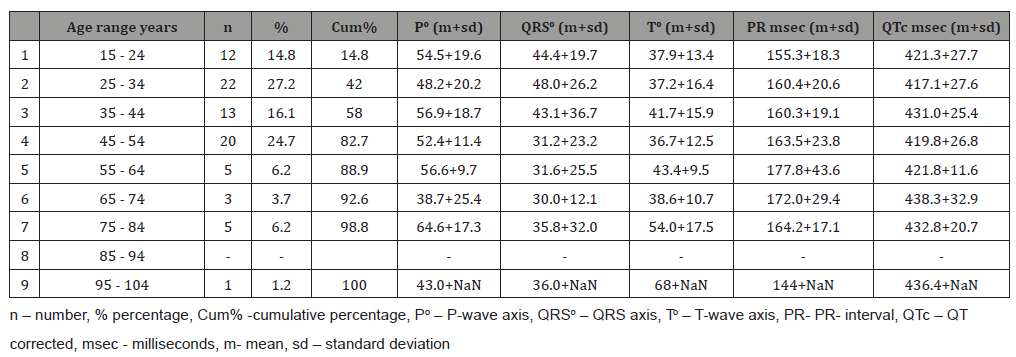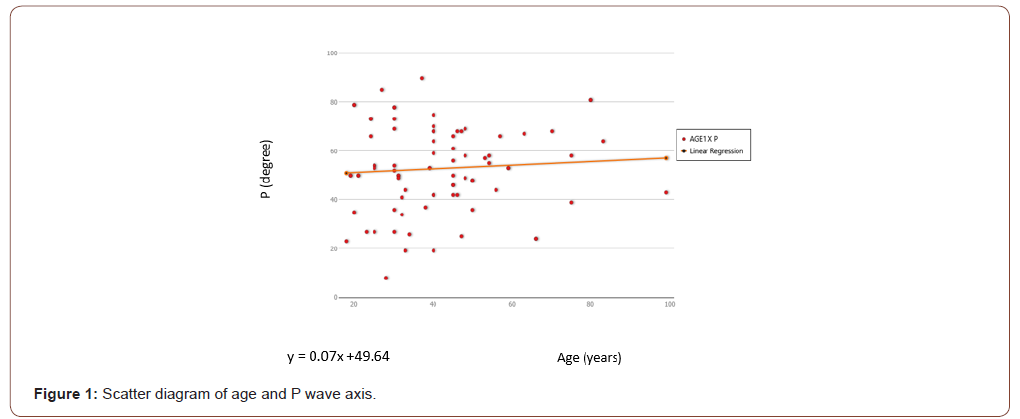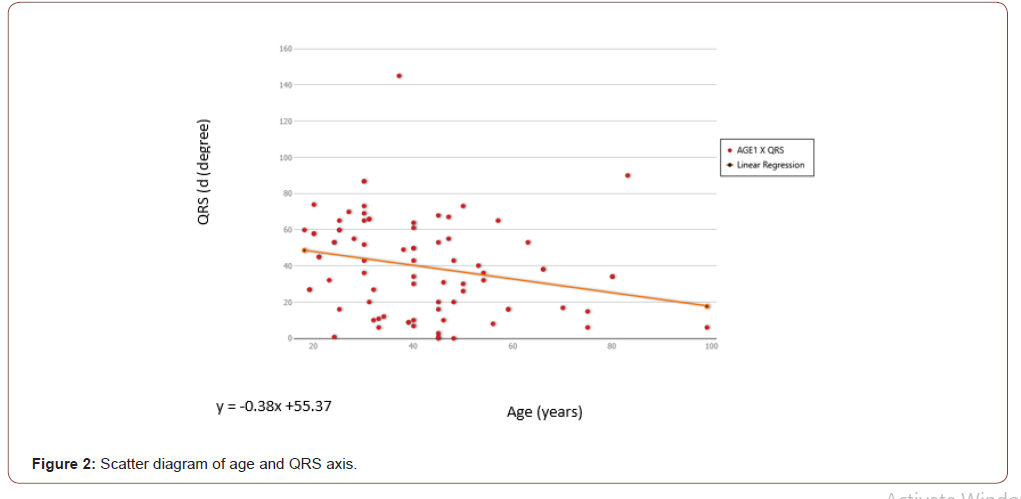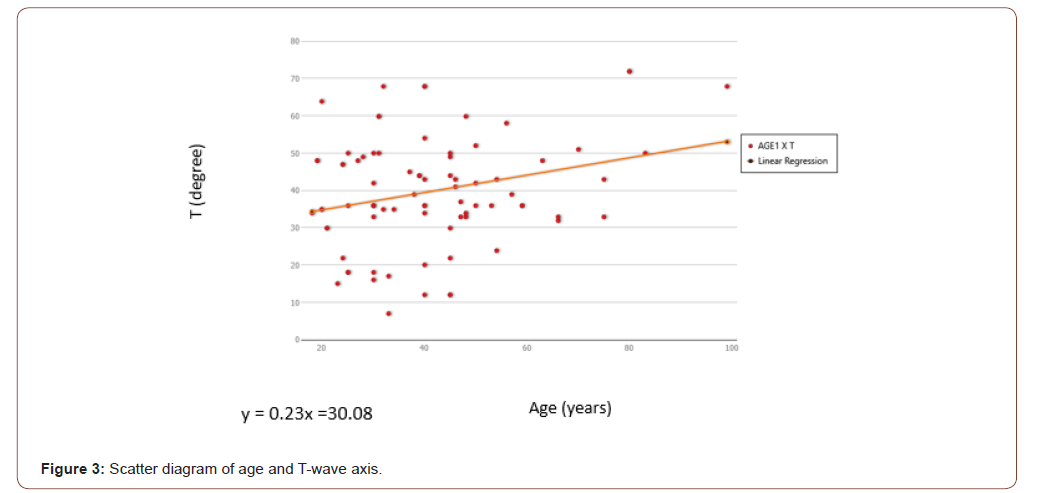 Review Article
Review Article
Normal P, QRS & T Axis on an Electrocardiogram (ECG) as Seen in Plateau Specialist Hospital, Jos. Central Nigeria
Chundusu CM1*, David N2, Badung D1
1 Department of Medicine, Jos University Teaching Hospital, Nigeria
2 Plateau Specialist Hospital, Nigeria
Chundusu CM, Department of Medicine, Jos University Teaching Hospital, Nigeria.
Received Date:August 27, 2020; Published Date:September 14, 2020
Abstract
Background: In making cardiovascular diagnosis, ECG stands out. QRS axis determination is the only considered axis. The P and T axis are most often ignored. Normal values of these axis need further scrutiny.
Materials and Methods: This was a secondary analysis carried out on a study on normal adult ECG in the ECG room of the Plateau State Hospital, Jos Nigeria. A number of normal ECG were reviewed over a 3-month period considering sex, age, PR interval, QTc and the P, QRS and T axis were analyzed. The axis was analyzed in relation to gender and age.
Results: A total of 81 normal ECG recordings with about 70% women with a mean age of 41 years with no significant gender difference were analyzed. Normal P axis (y = 0.07x +49.64) and normal T axis (y = 0.23x =30.08) had a positive relationship with age, while that of the normal QRS axis (y = -0.38x +55.37) was negative.
Conclusions: The normal P, QRS and T axis did not differ with gender. The normal P and T axis appear to increase slightly with age, the QRS axis which is the commonly observed axis appear to decrease with age.
Keywords: Normal P axis; QRS axis; T axis; gender; age
Introduction
The use of ECG in making diagnosis of heart diseases is widely accepted in most communities. however, the presence of a very few number of Specialists and health care providers having limited idea on the use of ECG has made it necessary to point out this basic information. It has been said that before one knows an abnormality one has to be conversant with what is normal. Determination of axis of the heart is one of the several uses of ECG tracing while making some diagnosis of heart diseases. The most commonly referred axis of the heart is the QRS axis, this generally gives an idea of the overall left ventricular vector direction. It can easily be determined using the standard limb leads (I, II & III). The P & T axis are less commonly considered. Most ECG machines have in-built interpreters that give all the P, QRS and T axis.
Documented characteristics of a P-wave mostly emphasis morphology, duration, and amplitude. Standard literature gives a normal P wave axis range OO to 750. P-wave axis abnormality has been documented in patient with SLE [1]. Ischemic stroke was also documented to be associated with abnormal P-wave axis, where it was found present not only on patient with AF resulting stroke alone. It was associated with increased mortality [2]. Normal QRS axis range between -30o to 90o in adults. It has been observed that at birth QRS axis range between 30o to 190o, by 6-8 years 0o to 120o [3]. This represents the major of ventricular activation dominated by the left ventricle. The terms left axis deviation, right axis deviation and extreme Heart axis describes various abnormalities. The main factors determining QRS axis are heart rotation, ventricular enlargement/hypertrophy, wall infarction and heart conduction defects. Normal T axis range between 15o -75o [3]. This is the marker of ventricular repolarization. It is similarly affected by factors affecting the QRS axis. When deviated by >60O in either direction is said to be associated with a cardiac event in adults [4,5].
Generally, a lot of factors need to be considered while interpreting an ECG. Patients age, gender, race, body habitus, heart orientation and physiology can affect the axis of the heart. Similarly, technicalities of procedure, posture, temperature, or eating can affect ECG interpretations. This analysis was carried out on the normal individual group of another study. We needed to know if there were some peculiar difference in normal individuals as compared to already documented study findings elsewhere.
Material and Method
The study was a descriptive study carried out in plateau state Hospital. A 400-500 bed capacity state hospital within Jos, Central Nigeria, rendering secondary health care and training of resident in family medicine. The institution runs an average of 100 ECG in a month. The study was carried out over a 3-month period.
Design
All ECG recordings in adult greater than 18 years during a 3-month period considered to be normal by the (iocare ECG-3010) ECG machine endorsed by a specialist in cardiology were compiled. The sex, age, PR interval, QTc with axis (P, QRS & T) were recorded for analysis. Ethical clearance was obtained from the management of the Plateau state hospital for the study Data collected were recorded as mean and standard deviation for categorical variables and percentages for proportions for non-categorical variables. Analysis was done with the use of Epi-info.7.1. student T-test was used to determine the difference between means of the sexes. A p-value of <0.005 was considered a significant difference between means. The 95% confidence interval was determine using 2020 MathIsFun.com v0.90 internet software. A liner regression was determined between the age and the three-normal axis.
Result
A total of 81 ECG records were analyzed consisting of 55 females and 26 adult males, With a mean age of 41years. No significant difference between gender findings.
Discussion
What is normal is the expected findings in a community, what is considered normal in on part of the world may not be particularly normal in another part. ECG is readily available, simple test to assess cardiovascular state that requires interpretation based on normal community findings. The need for knowing this community specific normal cannot be over emphasized. Cardiac axis was observed in this study. Gender did not appear to affect axis of the heart though other ECG parameters like voltage amplitude and QT interval have been shown to be affected by the gender of the individual [7] (Table 1). PR interval has been shown to progressively increased with age both in normal adults [8], and pediatrics [9]. We looked at it based on age groups and observed a slight progressive increased. Similarly, QTc increases with both age and male gender [10] and was also observed the same in the study. These findings give credence to the observations of subject less than 55 years in the study (Table 2 & 3).
Table 1: Age group proportions and findings.

Table 2: Gender difference of axis.

Table 3: Calculated reference range of variables.




The calculated reference range (95% confidence interval) was way narrower than published normal ranges. This resulted from the sample size of 81. However, these values were within the published normal ranges. Linear regression between age and normal p-wave axis shows a very slight positive relationship that (Figure 1). A negative relationship was observed when comparing age and QRS axis. Truncal obesity gets more prominent with age, and with elevation of the diaphragm by an increased in intraabdominal pressure. The resultant elevation of the heart reduces the QRS axis of the Heart (Figure 2). T-wave axis was observed to be slightly increased with age (Figure 3). This study was secondary observation made on another study, limitations was acknowledged by the number of normal subjects and representation of age groups above 55yrs old. Absence of height and weight (BMI) made our truncal obesity claim speculative while explaining reduction of QRS axis with age.
Conclusion
The normal P, QRS and T axis do not differ with gender. The P and T axis appear to increase slightly with age, the QRS axis which is the commonly observed axis appear to decrease with age. A wider research however is likely statistically significant indexes.
Acknowledgement
None.
Conflict of Interest
No conflict of interest.
References
- Acar RD, Bulut M, Acar S, Fidan S (2015) Evaluation of P-wave axis in patient with Systemic lupus Erythematosus. J cardiovasc Thorac Res 7(4): 154-157.
- Maheshwari A, Norby FL, Soliman EZ, Koene RJ (2017) Abnormal p-wave axis and Ischemic Stroke. The ARIC study. Stroke 48: 2060-2065.
- Bonow RO, Mann DL, Zipes DP, Libby P (2011) Braunwalds Heart Disease. A textbook of cardiovascular Medicine. (9th), USA.
- Scherer ML, Aspelund T, Sigurdur Sigurdsson, Robert Detrano, Melissa Garcia, et al. (2009) Abnormal T-axis is associated with coronary artery calcification in older adults. Scand Cardiovascular J 43(4): 240-248.
- Salles GF, Xavier SS, Sausa AS, Hasslocher-Moreno A, Claudia RL Cardoso (2004) T wave axis deviation as an independent predictor of mortality in chronic Chagas disease. Am J Cardiol 93(9): 1136-1140.
- Bangert SK, Marshal WJ, Leonard M (2008) Clinical Chemistry. Metabolic and clinical aspects. Philadelphia, USA.
- Johnson JN, Ackerman MJ (2009) QTc: how long is too long? British journal of sports medicine 43(9): 657-662.
- Wu J, Kors JA, Rijnbeek PR, Van-Herpen G, Zaiying Lu, et al. (2003) Normal limits of the ECG in Chinese subjects. In j Cardiol 87: 37-51.
- Alimurung MM, Massell BF (1956) The normal PR interval in infants and children. Circulation 13(2): 257-262.
- Rabkin SW, Cheng XJ, Thompson DJ (2016) Detailed analysis of the impact of age on the QT interval. Journal of Geriatric Cardiology 13(9): 740-748.
-
Chundusu CM, David N, Badung D. Normal P, QRS & T Axis on an Electrocardiogram (ECG) as Seen in Plateau Specialist Hospital, Jos. Central Nigeria. On J Cardio Res & Rep. 4(4): 2020. OJCRR.MS.ID.000593.
-
Normal P axis, QRS axis, T axis, Gender, Age, Cardiology, Electrocardiogram, Heart diseases, Heart rotation, Ventricular enlargement, Hypertrophy
-

This work is licensed under a Creative Commons Attribution-NonCommercial 4.0 International License.






